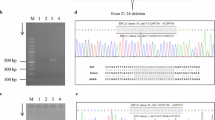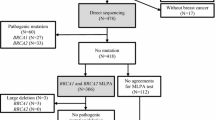Abstract
BRCA1 and BRCA2 are two major genes associated with familial breast and ovarian cancer susceptibility. In Poland standard BRCA gene test is usually limited to Polish founder BRCA1 mutations: 5382insC, C61G and 4153delA. To date, just a few single large genomic rearrangements (LGRs) of BRCA1 gene have been reported in Poland. Here we report the first comprehensive analysis of large mutations in BRCA1 and BRCA2 genes in this country. We screened LGRs in BRCA1 and BRCA2 genes by multiplex ligation-dependent probe amplification in 200 unrelated patients with strong family history of breast/ovarian cancers and negative for BRCA1 Polish founder mutations. We identified three different LGRs in BRCA1 gene: exons 13-19 deletion, exon 17 deletion and exon 22 deletion. No LGR was detected in BRCA2 genes. Overall, large rearrangements accounted for 3.7 % of all BRCA1 mutation positive families in our population and 1.5 % in high-risk families negative for Polish founder mutation.
Similar content being viewed by others
References
Górski B, Byrski T, Huzarski T, Jakubowska A et al (2000) Founder mutations in the BRCA1 gene in Polish families with breast-ovarian cancer. Am J Hum Genet 66:1963–1968
Grzybowska E, Zientek H, Jasinska A et al (2000) High frequency of recurrent mutations in BRCA1 and BRCA2 genes in Polish families with breast and ovarian cancer. Hum Mutat 16:482–490
van Der Looij M, Wysocka B, Brozek I et al (2000) Founder BRCA1 mutations and two novel germline BRCA2 mutations in breast and/or ovarian cancer families from North-Eastern Poland. Hum Mutat 15:480–481
Schouten JP, McElgunn CJ, Waaijer R et al (2002) Relative quantification of 40 nucleic acid sequences by multiplex ligation-dependent probe amplification. Nucleic Acids Res 30:e57
Puget N, Torchard D, Serova–Sinilnikova OM et al (1997) A 1-kb Alu-mediated germline deletion removing BRCA1 exon 17. Cancer Res 57:3–828
HGMB-The Human Gene Mutation Database at the Institute of Medical Genetics in Cardiff: http://www.hgmd.cf.ac.uk
Montagna M, Dalla Palma M, Menin C et al (2003) Genomic rearrangements account for more than one-third of the BRCA1 mutations in northern Italian breast/ovarian cancer families. Hum Mol Genet 12:1055–1061. doi:10.1093/hmg/ddg120
Hogervorst FB, Nederlof PM, Gille JJ et al (2003) Large genomic deletions and duplications in the BRCA1 gene identified by a novel quantitative method. Cancer Res 63:1449–1453
Sluiter MD, van Rensburg EJ (2011) Large genomic rearrangements of the BRCA1 and BRCA2 genes: review of the literature and report of a novel BRCA1 mutation. Breast Cancer Res Treat 125:325–349. doi:10.1007/s10549-010-0817-z
Ratajska M, Brozek I, Senkus–Konefka E et al (2008) BRCA1 and BRCA2 point mutations and large rearrangements in breast and ovarian cancer families in Northern Poland. Oncol Rep 19:263–268
Jakubowska A, Górski B, Byrski T et al (2001) Detection of germline mutations in the BRCA1 gene by RNA-based sequencing. Hum Mutat 18:149–156
denDunnen JT, Antonarakis SE (2001) Nomenclature for the description of human sequence variations. Hum Genet 109:121–124
ReapetMasker: http://www.repeatmasker.org
Agata S, Viel A, Della Puppa L, Cortesi L et al (2006) Prevalence of BRCA1 genomic rearrangements in a large cohort of Italian breast and breast/ovarian cancer families without detectable BRCA1 and BRCA2 point mutations. Genes Chromosom Cancer 45:791–797
Hartmann C, John AL, Klaes R et al (2004) Large BRCA1 gene deletions are found in 3 % of German high-risk breast cancer families. Hum Mutat 24:534
Gad S, Caux–Moncoutier V, Pagès–Berhouet S et al (2002) Significant contribution of large BRCA1 gene rearrangements in 120 French breast and ovarian cancer families. Oncogene 21:6841–6847
Vasickova P, Machackova E, Lukesova M et al (2007) High occurrence of BRCA1 intragenic rearrangements in hereditary breast and ovarian cancer syndrome in the Czech Republic. BMC Med Genet 8:32. doi:10.1186/1471-2350-8-32
Thomassen M, Gerdes AM, Cruger D et al (2006) Low frequency of large genomic rearrangements of BRCA1 and BRCA2 in western Denmark. Cancer Genet Cytogenet 168:168–171
Krajc M, Teugels E, Zgajnar J et al (2008) Five recurrent BRCA1/2 mutations are responsible for cancer predisposition in the majority of Slovenian breast cancer families. BMC Med Genet 9:83. doi:10.1186/1471-2350-9-83
Walsh T, Casadei S, Coats KH et al (2006) Spectrum of mutations in BRCA1, BRCA2, CHEK2, and TP53 in families at high risk of breast cancer. JAMA 295:1379–1388
Palma MD, Domchek SM, Stopfer J et al (2008) The relative contribution of point mutations and genomic rearrangements in BRCA1 and BRCA2 in high-risk breast cancer families. Cancer Res 68:7006–7014. doi:10.1158/0008-5472
Distelman–Menachem T, Shapira T, Laitman Y et al (2009) Analysis of BRCA1/BRCA2 genes’ contribution to breast cancer susceptibility in high risk Jewish Ashkenazi women. Fam Cancer 8:127–133. doi:10.1007/s10689-008-9216-6
Stadler ZK, Saloustros E, Hansen NA et al (2011) Absence of genomic BRCA1 and BRCA2 rearrangements in Ashkenazi breast and ovarian cancer families. Breast Cancer Res Treat 123:581–585. doi:10.1007/s10549-010-0818-y
Ticha I, Kleibl Z, Stribrna J et al (2010) Screening for genomic rearrangements in BRCA1 and BRCA2 genes in Czech high-risk breast/ovarian cancer patients: high proportion of population specific alterations in BRCA1 gene. Breast Cancer Res Treat 124:337–347. doi:10.1007/s10549-010-0745-y
Janavičius R (2010) Founder BRCA1/2 mutations in the Europe: implications for hereditary breast-ovarian cancer prevention and control. EPMA J 1:397–412. doi:10.1007/s13167-010-0037-y
Petrij–Bosch A, Peelen T, van Vliet M et al (1997) BRCA1 genomic deletions are major founder mutations in Dutch breast cancer patients. Nat Genet 17:341–345
Hendrickson BC, Judkins T, Ward B et al (2005) Prevalence of five previously reported and recurrent BRCA1 genetic rearrangement mutations in 20,000 patients from hereditary breast/ovarian cancer families. Genes Chromosom Cancer 43:309–313
Mazoyer S (2005) Genomic rearrangements in the BRCA1 and BRCA2 genes. Hum Mutat 25:415–422
Peelen T, van Vliet M, Bosch A et al (2000) Screening for BRCA2 mutations in 81 Dutch breast-ovarian cancer families. Br J Cancer 82:151–156
Lahti–Domenici J, Rapakko K, Pääkkönen K et al (2001) Exclusion of large deletions and other rearrangements in BRCA1 and BRCA2 in Finnish breast and ovarian cancer families. Cancer Genet Cytogenet 129:120–123
Agata S, Dalla Palma M, Callegaro M et al (2005) Large genomic deletions inactivate the BRCA2 gene in breast cancer families. J Med Genet 42:e64. doi:10.1136/jmg.2005.032789
Tournier I, Paillerets BB, Sobol H et al (2004) Significant contribution of germline BRCA2 rearrangements in male breast cancer families. Cancer Res 64(22):8143–8147
Casilli F, Tournier I, Sinilnikova OM et al (2006) The contribution of germline rearrangements to the spectrum of BRCA2 mutations. J Med Genet 43:e49
Gutiérrez–Enríquez S, de la Hoya M, Martínez–Bouzas C et al (2007) Screening for large rearrangements of the BRCA2 gene in Spanish families with breast/ovarian cancer. Breast Cancer Res Treat 103:103–107. doi:10.1007/s10549-006-9376-8
Del Valle J, Feliubadalo L, Nadal M et al (2009) Identification and comprehensive characterization of large genomic rearrangements in the BRCA1 and BRCA2 genes. Breast Cancer Res Treat 122:733–743. doi:10.1007/s10549-009-0613-9
Nordling M, Karlsson P, Wahlström et al (1998) A large deletion disrupts the exon 3 transcription activation domain of the BRCA2 gene in a breast/ovarian cancer family. Cancer Res 58:1372–1375
Machado PM, Brandão RD, Cavaco BM et al (2007) Screening for a BRCA2 rearrangement in high-risk breast/ovarian cancer families: evidence for a founder effect and analysis of the associated phenotypes. J ClinOncol 25:2027–2034. doi:10.1200/JCO.2006.06.9443
Peixoto A, Santos C, Rocha P et al (2009) The c.156_157insAlu BRCA2 rearrangement accounts for more than one-fourth of deleterious BRCA mutations in northern/central Portugal. Breast Cancer Res Treat 114:31–38. doi:10.1007/s10549-008-9978-4
Woodward AM, Davis TA, Silva AG et al (2005) Large genomic rearrangements of both BRCA2 and BRCA1 are a feature of the inherited breast/ovarian cancer phenotype in selected families. J Med Genet 42(5):e31
Conflict of interest
No conflicts of interest to be disclosed.
Author information
Authors and Affiliations
Corresponding author
Electronic supplementary material
Below is the link to the electronic supplementary material.
Rights and permissions
About this article
Cite this article
Rudnicka, H., Debniak, T., Cybulski, C. et al. Large BRCA1 and BRCA2 genomic rearrangements in Polish high-risk breast and ovarian cancer families. Mol Biol Rep 40, 6619–6623 (2013). https://doi.org/10.1007/s11033-013-2775-0
Received:
Accepted:
Published:
Issue Date:
DOI: https://doi.org/10.1007/s11033-013-2775-0




